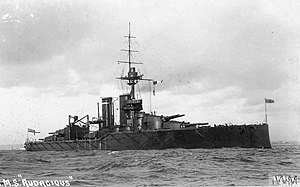 Audacious about 1913–1914
| |
| History | |
|---|---|
| Name | Audacious |
| Ordered | 1910 |
| Builder | Cammell Laird, Birkenhead |
| Laid down | 23 March 1911 |
| Launched | 14 September 1912 |
| Completed | August 1913 |
| Commissioned | 15 October 1913 |
| Fate | Sunk by a mine, 27 October 1914 |
| General characteristics (as built) | |
| Class and type | King George V-class dreadnought battleship |
| Displacement | 25,420 long tons (25,830 t) (normal) |
| Length | 597 ft 9 in (182.2 m) (o/a) |
| Beam | 89 ft 1 in (27.2 m) |
| Draught | 28 ft 8 in (8.7 m) |
| Installed power |
|
| Propulsion | 4 × shafts; 2 × steam turbine sets |
| Speed | 21 knots (39 km/h; 24 mph) |
| Range | 5,910 nmi (10,950 km; 6,800 mi) at 10 knots (19 km/h; 12 mph) |
| Complement | 860 (1914) |
| Armament |
|
| Armour | |
HMS Audacious was the fourth and last King George V-class dreadnought battleship built for the Royal Navy in the early 1910s. After completion in 1913, she spent her brief 2-year career assigned to the Home and Grand Fleets. The ship struck a German naval mine off the northern coast of County Donegal, Ireland, early during the First World War. Audacious slowly flooded, allowing all of her crew to be rescued, and finally sank after the British were unable to tow her to shore. However, a petty officer on a nearby cruiser was killed by shrapnel when Audacious subsequently exploded. Even though American tourists aboard one of the rescuing ships photographed and filmed the sinking battleship, the Admiralty embargoed news of her loss in Britain to prevent the Germans from taking advantage of the weakened Grand Fleet. She is the largest warship ever sunk by naval mines.[1]
- ^ Pemsel, p. 160